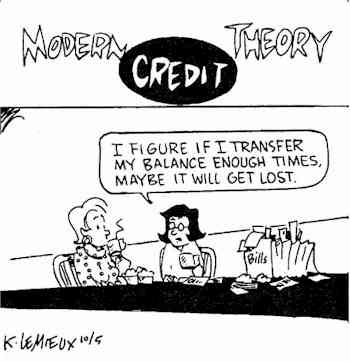We'll Pay You!
Cosy Credit Card CartelLife was a lot simpler when what we honored was father and mother rather than all major credit cards. - Robert Orben A Credit Rip-off? It's the Usual Poor SuckersDon't expect the rich to worry about bank charges - their cards make them richer.
The first twist is that the winners and losers from the rip-off aren't as obvious as you may think. It turns out that people who don't use cards are losers from them, whereas some people who do are winners. The other twist is the source of the rip-off. Most of us imagine that the banks make their excessive profits from credit cards through the high interest rates they charge. There may be something in this. Interest rates on credit cards are far higher than the banks' comparable products. But the interest margin on credit cards accounts for only half the banks' revenue from those cards. More than a third of it comes from something called "interchange fees". Never heard of them? That's because you've never seen them and don't know you're paying them. But they're, what, in my opinion, turn credit cards into a racket. When you buy something using your card, the shopkeeper (known as the "merchant") passes the charge on to his or her bank (the "acquirer") for payment. The acquiring bank passes the charge on to the bank that issued your card (hence, the "issuer") for payment. Your bank pays up and puts the charge on your credit card bill. That's pretty obvious. What's not obvious is the fees that get added along the way. First, the acquiring bank has to pay the issuing bank an interchange fee. This fee averages 0.95% of the value of the transaction. (Since the average transaction is about $100, the average fee is 95¢.) But, using figures supplied by the banks, the report estimates that the administrative and other costs faced by the issuing bank average, at most, only 41¢ per transaction. So interchange fees are set at a level way above what would be needed to yield the issuer - your bank - a reasonable profit on the deal. Next, though this wildly excessive interchange fee is paid initially by the acquiring bank, that bank passes it back to its customer, which is the merchant you bought from. In the process, the acquirer adds an amount to cover his costs in processing the transaction plus, of course, a profit margin. But get this: the average fee charged back to merchants - the "merchant service fee" - is 1.78% (or $1.78 for the average transaction). And, according to the report's figuring, this fee exceeds the combined amount of the interchange fee and the acquirer's costs by 29¢ - representing a markup over the acquirer's own costs of well over 50%. So the merchant service fee of 1.78% is hugely inflated. It far exceeds the relevant administrative and other costs borne by both the acquiring and the issuing banks. This brings us to the puzzle of just who's being ripped off. The merchants, naturally, pass the cost of their merchant service fees back to their customers. In a fair and open world, they'd impose it as a surcharge on those of their customers who chose to pay by credit card. But the rules of the two international credit card schemes - MasterCard and Visa - expressly prohibit merchants from doing this. So the merchants build their service fees into their regular prices - with the result that those of their customers who don't pay by credit card are obliged to bear much of the costs generated by those who do. This unfair twist hits the poor harder than the rich. A survey by Roy Morgan confirms that higher-income earners are much more likely to have a credit card than lower-income earners. The next stage of the puzzle of just who's being ripped off brings us to the question of how those of us who do use credit cards actually do so. As you know, with most cards it's possible to get up to 55 days of free credit on your purchases, provided you pay your bill in full each month. This is what the smarties do. They're well-lined, with enough spare cash in their bank account, and they don't really need to borrow. But when a bank offers them "free" credit, they take it. All it really costs them is the annual fee on their card, which averages about $20. In recent years, however, the banks have been offering them a further inducement to use their cards rather than pay cash: "loyalty" or reward points with every purchase. The report estimates that, far from paying to use their cards, the smarties are actually being paid. Their interest-free period is said (conservatively) to be worth about 40¢ a transaction, while the reward points are worth between 30 and 60¢ a transaction. So, in effect, they're being paid up to 1% the value of their purchases to avail themselves of the free credit. Needless to say, this gaping loophole in the credit card system also favors the better-off over the battlers. It's high time the authorities took steps to bust open the banks' cosy credit card cartel. Having exposed the racket, they now have to fix it. Ross Gittins is a staff writer. E-mail: opinion@theage.fairfax.com.au Source: The Age Wednesday 18 October 2000 Opinions theage.com.au
Update: NZ May Be Hit by New Aussie Credit Card Rulesby Karen Chan New Zealanders could be next to be hit by new credit card charges if regulators decide to copy Australian rules allowing merchants to pass on credit card transaction fees to card users. Credit card reforms that came into force in Australia on 1 January pave the way for fees of between A$1 and A$4 to be charged on every A$100 transaction. According to The Australian newspaper, Qantas and Caltex will be among the first companies to take advantage of the new rules. It said Qantas was believed to be planning to charge customers a flat fee, though the company would say only that it was still considering its options. Caltex was planning to introduce a credit card surcharge in company-owned petrol stations. Though surcharges should be about 1 to 4% of the value of the transaction, the new Australian laws set no limit on the rate. The developments are being closely watched by New Zealand regulators. Banking experts have said the reforms – part of sweeping changes aimed at reducing interest rates and the fees banks charge merchants for credit card transactions – are likely to have an impact in New Zealand. Source: Stuff 4 January 2003
Who benefits here? The merchants, certainly. And the people who don't need to charge because this may (may!) remove some of the upward pressure on prices. Can people barely making ends meet and living on credit afford still more fees? Look for a rise in bankruptcies and more onerous bankruptcy laws in the future. Followed by higher taxes. There's no free lunch. See also:
Source: Funny Times December 2001 funnytimes.com
A Brief History of the Credit Card1914 - Western Union, America's leading telegraph company, issues what is believed to be the first charge card, a small metal plate that looks like a military dog tag and bears the customer's name. Using the card, a customer can send large numbers of cables, then pay for them all at the end of the month from an itemised bill. 1924 - General Petroleum Corporation of California issues the first gasoline card to its employees and select customers. Mobil and Shell soon follow suit. 1930 - AT&T introduces the Bell System Credit Card, designed to build customer loyalty. Railroads and airlines soon follow AT&T's lead, issuing what became known as "fidelity cards." 1950 - Frank McNamara, owner and president of Hamilton Credit, which makes loans to small businesses, dines out in Manhattan and tries settling his bill using a small cardboard card that he signs. It works. McNamara later founds Diners Club, offering the first charge card to 200 people and signing up 14 Manhattan restaurants. Balances must be paid in full each month. 1951 - Franklin National Bank of New York introduces the first bank credit card that allows people to buy now and pay later. 1958 - The American Express charge card, made of paper and coloured purple, is launched. By the year's end, the company claims 250,000 cardholders paying $6 a year. Bank of America introduces its BankAmericard, which later becomes Visa. 1959 - American Express introduces the first plastic charge card. 1960s - The growth of the credit card industry is fuelled by compacts between states allowing banks to branch across state lines. 1966 - A group of banks forms the Interbank Card Association, the precusor of MasterCharge and MasterCard, agreeing to accept one another's credit cards. 1969 - The American Express card becomes green, the colour of money. MasterCharge is launched. The company says it issued 36.5 million cards in the first year. Diners Club introduces the first charge card in the Soviet Union. 1972 - American Express introduces a magnetic strip on the back of each card for more accurate authorisations. 1977 - American Express introduces the first premium "gold" card. 1979 - MasterCharge is renamed MasterCard. 1981 - MasterCard introduces its first premium "gold" card. 1986 - The Discover card is launched, owned by retailer Sears Roebuck and has 12 million cardholders by the year's end. Unlike other major credit cards, Discover is used only in the United States. It now is owned by the brokerage firm Morgan Stanley Dean Witter. 1990 - Life magazine calls Frank McNamara, who had died in 1957 at age 40, one of the 100 most influential Americans of the 20th century. An estimated 122 million Americans had at least one charge or credit card according to the Consumer Federation of America. The average US credit card debt per household was $2,985. 2000 - The number of people in the US with at least one charge card grew to 157 million, more than half the adult population, and the average household debt rose to $8,123. Annual credit card purchases in the US passed the $1 trillion mark for the first time. Information was supplied by Visa, MasterCard and the Associated Press Source: The Sunday Star Ledger Morris County, New Jersey 5 August 2001
For more articles relating to Money, Politics and Law including globalisation, tax avoidance, consumerism, credit cards, spending, contracts, trust, stocks, fraud, eugenics and
more click the "Up" button below to take you to the Table of Contents for this section. |
 Animals
Animals Animation
Animation Art of Playing Cards
Art of Playing Cards Drugs
Drugs Education
Education Environment
Environment Flying
Flying History
History Humour
Humour Immigration
Immigration Info/Tech
Info/Tech Intellectual/Entertaining
Intellectual/Entertaining Lifestyles
Lifestyles Men
Men Money/Politics/Law
Money/Politics/Law New Jersey
New Jersey Odds and Oddities
Odds and Oddities Older & Under
Older & Under Photography
Photography Prisons
Prisons Relationships
Relationships Science
Science Social/Cultural
Social/Cultural Terrorism
Terrorism Wellington
Wellington Working
Working Zero Return Investment
Zero Return Investment So you've always
thought the banks' credit cards were a rip-off. Well, now we have an official report from the Reserve Bank and the Australian
Competition and Consumer Commission that proves you're right. But the racket that report exposed has far more twists and turns than last week's headlines revealed.
So you've always
thought the banks' credit cards were a rip-off. Well, now we have an official report from the Reserve Bank and the Australian
Competition and Consumer Commission that proves you're right. But the racket that report exposed has far more twists and turns than last week's headlines revealed.